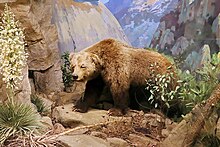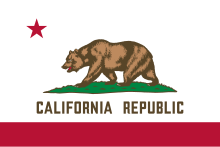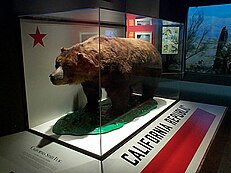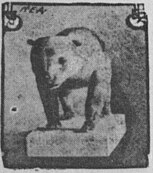California grizzly bear
| California grizzly bear | |
|---|---|

| |
| Specimen at theSanta Barbara Museum of Natural History | |
| Scientific classification | |
| Domain: | Eukaryota |
| Kingdom: | Animalia |
| Phylum: | Chordata |
| Class: | Mammalia |
| Order: | Carnivora |
| Family: | Ursidae |
| Genus: | Ursus |
| Species: | U. arctos |
| Subspecies: | †U. a. californicus |
| Trionomial name | |
| †Ursus arctos californicus (Merriam, 1896)[2] | |
| Synonyms | |
|
List:
| |
TheCalifornia grizzly bear(Ursus arctos californicus[3]), also known as theCalifornia golden bear,[4]is anextinctpopulationof thebrown bear,[5]generally known (together with otherNorth Americanbrown bear populations) as thegrizzly bear."Grizzly" could have meant "grizzled" – that is, with golden and grey tips of the hair – or "fear-inspiring" (as a phonetic spelling of "grisly" ).[6][7]Nonetheless, after careful study, naturalistGeorge Ordformally classified it in 1815 – not for its hair, but for its character – asUrsus horribilis( "terrifying bear" ).[8]Genetically, North American brown bears are closely related;[9]in size and coloring, the California grizzly bear was much like theKodiak bearof the southern coast of Alaska. The grizzly became a symbol of theBear Flag Republic,a moniker that was attached to the short-lived attempt by a group of U.S. settlers to break away from Mexico in 1846. Later, this rebel flag became the basis for the stateflag of California,and then California was known as the "Bear State".[10]
Taxonomy
[edit]A 1953 researcher stated, "The specific status of North Americanbrown bears(or grizzly bears) is one of the most complex problems of mammalian taxonomy. The difficulty stems directly from the work ofMerriam(1918), who concluded that there are 86 forms of grizzlies (and brown bears) in North America. "[11]
North American brown bears were taxonomically grouped as a species apart from other bear species, until DNA testing revealed that they should properly be grouped in the same species as the other brown bears.[9]Grizzlies living in California had been classified by Merriam into many subspecies.[12][13]A recent study based on mitochondrial DNA suggests that the only genetically anomalous grouping of grizzly bears is theABC Islands bear,implying that previous grizzly bear subspecies designations are unwarranted.[9]However, a formal taxonomic synonymy was not performed, and mitochondrial introgression is known to be an issue in brown bears.[14][3]Pending further taxonomic resolution, the subspecies is provisionally accepted as separate.[3]
Appearance
[edit]The California grizzly was historically considered an enormous bear. FatherPedro Font,an early missionary, described the local grizzly bears, writing, "He was horrible, fierce, large, and fat."[15]In the 1800s, multiple newspaper accounts mentioned bears weighing well over 1,000 pounds (450 kg); the hind foot of one particular adult male grizzly was measured at 12 inches (300 mm) long by 8 inches (200 mm) wide, and claws were often 2 inches (51 mm) wide by 3.5 inches (89 mm) long.[16]Measurements of museum specimens, however, demonstrate that this bear was no larger than those present in the rest of North America, with average body size estimates ranging from 104 kilograms (229 lb) to 252 kilograms (556 lb) depending on methodology.[3]
The fur of the California grizzly bear has been described as golden brown,[17]leading to the occasional name "California golden bear". The captive individual "Monarch" had a dark brown, almost black, pelt.[18][19]
Diet and behavior
[edit]The diet of the California grizzly bear was diverse, ranging from plant sources like grasses, seeds, berries, and acorns, to animal sources such as elk, deer,salmon,steelhead,and carrion.[20][21][15]Isotopic study indicates that the majority of the diet consisted of plant matter, as with other grizzly bear populations.[3]Anecdotal reports from Spanish explorers reported California grizzly bears scavenging on beachedwhalecarcasses.[10][22]After the introduction of European livestock, California grizzly bears increasingly incorporated cattle into their diets.[3]California grizzly bears were primarily solitary, except for mothers with cubs, but foraging groups of up to 40 have been reported.[20][23]
Distribution and habitat
[edit]Prior toSpanish settlement in the second half of the 1700s,it is estimated that 10,000 grizzly bears inhabited what is modern-day California.[24][25]It is thought that the bears lived across almost the entirety of the state, save its most southeastern and northeastern corners.[10][26]Probably the southernmost records for this subspecies are from theSierra de Juárez,during the 18th century. The bear was most abundant in chaparral, oak woodland, and hardwood forests.[10]
Relationship with humans
[edit]European contact
[edit]The first documented sighting of a grizzly bear in California occurred in 1603 when aSpanish explorernearMontereydescribed how bears came down to feed on a whale carcass stranded on the beach. However, his reports were not widely circulated, so the existence of grizzlies in California was not well-known to Europeans until the eighteenth century.[10]
Western Europeans' first well-circulated encounters with California grizzly bears are found in diaries kept by several members of the 1769Portola expedition,the first European land exploration of what is now the state of California. Several place names that include the Spanish word for bear (oso) trace their origins back to that first overland expedition (e.g.Los Osos). As the settled frontier ofNew Spainwas extended northward, settlers began to populate California and establish large cattle herds as the main industry. The ranchers' livestock were easy prey for the largely herbivorous-omnivorous grizzly bears found across the state. In turn, grizzly populations increased around human settlements.[10]By eating their livelihood, and scaring them, the grizzlies became enemies of therancheros.Vaqueroshunted the grizzlies, often roping and capturing them alive to be pitted against other animals in public battles (bloodsports).[10]
In 1866, a grizzly bear described as weighing as much as 2,200 pounds (1,000 kg) was killed in what is present-dayValley Center, California,in the north-central area ofSan Diego County.The incident was recalled in 1932 by Catherine E. Lovett Smith, who witnessed the bear's killing on her family's ranch when she was just six years old. If its measurements are accurate, this particular bear was the biggest bear ever found in California and one of the largest specimens of any bear species ever recorded. (Other sources confirm Lovett Smith's account of the bear, but differ as to its exact size.) Her telling of that bear is part of the oral history of "Bear Valley", the original name for Valley Center.[25]The bear was prominent in theBig Surregion of the central California coast.Frank Post,born in 1859 on the Soberanes Ranch in Big Sur, remembered when his family lived at Soberanes Creek, during the American Civil War – recalling the "Great Sur Bears".[15]Inhabiting most of the state, both inland and coastally, it is likely the California grizzly's southernmost range in the state overlapped with that of the now-extinctMexican grizzly bear,as well.
Extinction
[edit]
In the late 1700s, Spanish ranchers placed a poisoned "bait ball" made of suet or swine entrails filled with a lethal dose ofstrychninewhich they hung from the branches of a tree within reach of the bear but out of reach of dogs and children.[15][27]: 21 Mexican settlers captured bears for bear and bull fights and they also sold their skins for 6 to 10 pesos to trading ships. Bear Trap Canyon nearBixby Creekwas one of their favorite sites for trapping grizzly bears along the central California coast.[28][29]These bears were even turned into furniture, such as a chair gifted to President Andrew Johnson in 1865.[30]
Bear-baitingevents flourished as popular spectacles in 19th century California.[31]Bloody fights that pitted bears againstbulls[10]often inspired betting as to whetherthe bear or the bullwould win. One persistently popular, butfalse[32]phrase origin story related to these fights stems from famous 19th-century newspapermanHorace Greeley.While visiting California, Greeley allegedly witnessed such a fight, and supposedly gave the modern stock market its "bear"and"bull"nicknames based on the fighting styles of the two animals: the bear swipes downward while the bull hooks upward. In truth, the phrase's origins predate Greeley's 1859 journey to California by at least 100 years,[33]but the myth of the California connection persists.

The Monterey County Heraldnoted on July 4, 1874:
Last Monday, Captain A. Smith, who resides about ten miles from town, in the Carmel Valley, succeeded in poisoning a large grizzly bear. Bruin had been annoying the neighborhood by destroying cattle, etc., for several years past, and all efforts to exterminate him seem futile. In some manner, however, he was induced partake of that "cold pizen" the captain had prepared for his special benefit. He is not likely to repeat his experiment.[15]
In the early to mid 19th century, livestock from theranchos of Californiaprovided an abundant food source for the bears, allowing the grizzly population to expand rapidly. However, the cattle population was greatly diminished following extreme drought and flooding in the 1860s and 1870s, leading to a reduction in the number of grizzlies.[34]This coincided with an increased interest in bear hunting, both for sport and commercial purposes. Grizzly bear meat became a mainstay on restaurant menus in theSan Gabrielarea; according toMike Davis,“The paws from adult bears and the flesh from young cubs were deemed particular delicacies.”[34]
European settlers paid bounties on the bears who regularly preyed on livestock until the early 20th century.[35][36]: 4 Absolom (Rocky) Beasley hunted grizzly bears throughout theSanta Lucia Mountainsand claimed to have killed 139 bears in his lifetime.[37]Noted Californiamountain manSeth Kinmanclaimed to have shot over 800 grizzly bears in a 20 year period in the areas surrounding present dayHumboldt County.One prospector in Southern California,William F. Holcomb(nicknamed "Grizzly Bill" Holcomb), was particularly well known for hunting grizzly bears in what is nowSan Bernardino County.
During September 1897, in the mountains between Inwood and Mt. Lassen,Shasta County,21-year-old Elias Weigart and his dog encountered a huge California grizzly whose front track measured 11 inches and the rear, 19. The bear died after Weigart emptied his Winchester 38-55 into the beast at close range.[38]
The last hunted California grizzly bear was shot inTulare County, California,in August 1922, although no body, skeleton or pelt was ever produced. Less than 75 years after the discovery of gold in 1848, almost every grizzly bear in California had been tracked down and killed. In 1924, what was thought to be a grizzly was spotted inSequoia National Parkfor the last time and thereafter, grizzlies were never seen again in California.[25][39][23][40]
Reintroduction
[edit]Support to reintroduce grizzlies to the state is growing.[41]Despite having one of the largestAmerican black bearpopulations in the nation, California still has habitat that can sustain about 500 grizzlies; it is thought that the presence of an additional large mammal could curb overpopulation of the smaller black bear, which often is involved in human-bear conflicts, as it enters human settlements in pursuit of food and trash.[24]In 2014, theU.S. Fish and Wildlife Servicereceived, and subsequently rejected, a petition to reintroduce grizzly bears to California.[42][43]In 2015, the Center for Biological Diversity launched a petition aimed at theCaliforniastate legislature to reintroduce the grizzly bear to the state.[44][45][46]
In anticipation of the 2024 centennial marking the final recorded sighting of a wild grizzly bear in California, a collaborative effort was initiated by scientists affiliated with the Research Network, prominent leaders from California Tribes, and advocates associated with conservation nonprofits. This initiative resulted in the establishment of the California Grizzly Alliance.[47]
Despite these efforts, however, their reintroduction remains controversial. Arguments against grizzly bear reintroduction emphasize the potential for rare but significant harm, such as attacks causing injuries or fatalities. Those who deem any harm, especially loss of human life, as morally unacceptable view the reintroduction in California as an intolerable threat, regardless of individual risk.[41]
Symbolism
[edit]
The California grizzly bear is one of the state's most visible and enduring symbols, adorning both the state flag and seal. The Bear Flag first flew in 1846 as a symbol of the short-livedCalifornia Republic.A second version was adopted as the state flag by the state legislature in 1911.[48]The bear symbol became a permanent part of the state seal in 1849. The California grizzly bear was designated the official state animal in 1953.[49][50]The bear is celebrated in name and as mascot of the sports teams of theUniversity of California, Berkeley(theCalifornia Golden Bears), and of theUniversity of California, Los Angeles(theUCLA Bruins) and in the mascot ofUniversity of California, Riverside(theUC Riverside Highlanders). TheCalifornia Maritime Academyoperates a training ship namedGolden Bear.
References
[edit]- ^IUCN (February 2, 2016)."Ursus arctos: McLellan, B.N., Proctor, M.F., Huber, D. & Michel, S.: The IUCN Red List of Threatened Species 2017: e.T41688A121229971".doi:10.2305/iucn.uk.2017-3.rlts.t41688a121229971.en.RetrievedOctober 7,2023.
- ^Merriam 1896,pp. 76–77
- ^abcdefMychajliw, Alexis M.; Adams, Andrea J.; Brown, Kevin C.; Campbell, Beau T.; Hardesty-Moore, Molly; Welch, Zoë S.; Page, Henry M.; Southon, John R.; Cooper, Scott D.; Alagona, Peter S. (2024)."Coupled social and ecological change drove the historical extinction of the California grizzly bear (Ursus arctos californicus) "(PDF).Proceedings of the Royal Society B.290(2014) 20230921.doi:10.1098/rspb.2023.0921.PMC10777157.PMID38196370.
- ^Hall, E. Raymond (August 10, 1984),"Geographic variation among brown and grizzly bears (Ursus arctos) in North America ",Special publication 13,University of Kansas Museum of Natural History,retrievedSeptember 24,2011
- ^"Ursus arctos.NatureServe Explorer 2.0 ".explorer.natureserve.org.RetrievedSeptember 14,2023.
- ^Wright, William Henry (1909),The Grizzly Bear: The Narrative of a Hunter-naturalist, Historical, Scientific and Adventurous
- ^Rose, Ian (April 25, 2024)."Frontier myth vilified the California grizzly. Science tells a new story".The Washington Post.RetrievedApril 27,2024.
- ^Grisly indeed, Grizzly Island was aptly named ". Daily Republic. Retrieved 5 May 2011.
- ^abcMiller, C.; Waits, L.; Joyce, P. (2006). "Phylogeography and mitochondrial diversity of extirpated brown bear (Ursus arctos) populations in the contiguous United States and Mexico ".Mol Ecol.15(14): 4477–4485.Bibcode:2006MolEc..15.4477M.doi:10.1111/j.1365-294X.2006.03097.x.PMID17107477.S2CID7336900.
- ^abcdefghStorer, T.I.; Tevis, L.P. (1996).California Grizzly.Berkeley, CA:University of California Press.ISBN978-0-520-20520-8.Archived fromthe originalon September 7, 2012.
- ^Rausch, Robert L. (July 1953). "On the Status of some Arctic Mammals".Journal of the Arctic Institute of North America.6(2). Faculty Publications from the Harold W. Manter Laboratory of Parasitology. Paper 497.
- ^Merriam, C. Hart(August 13, 1914),"Description of Thirty apparently New Grizzly and Brown Bears from North America",Proceedings of the Biological Society of Washington,27:173–196,retrievedSeptember 24,2011
- ^Merriam, C. Hart(September 6, 1916),"Nineteen Apparently New Grizzly and Brown Bears from Western America",Proceedings of the Biological Society of Washington,29:133–154,retrievedSeptember 24,2011
- ^de Jong, Menno J.; Niamir, Aidin; Wolf, Magnus; Kitchener, Andrew C.; Lecomte, Nicolas; Seryodkin, Ivan V.; Fain, Steven F.; Hagen, Snorre B.; Saarma, Urmas; Janke, Axel (2023)."Range-wide whole-genome resequencing of the brown bear reveals drivers of intraspecies divergence".Communications Biology.6(1) 15: 153.doi:10.1038/s42003-023-04514-w.hdl:11250/3092374.PMC9902616.PMID36746982.
- ^abcdeMiller, Adam (January 14, 2021)."The Folklore of Big Sur".Archived fromthe originalon February 17, 2022.RetrievedFebruary 17,2022.
- ^Skillen, Jennie; Medeiros, Joe (2018)."Journal of Sierra Nevada History & Biography".sierracollege.edu.Archived fromthe originalon November 13, 2021.RetrievedNovember 13,2021.
- ^"Animal – California Grizzly Bear | California State Capitol Museum".October 13, 2021.RetrievedOctober 17,2023.
- ^Fimrite, Peter (May 3, 2011)."CA grizzly bear Monarch: a symbol of suffering".SFGate.Hearst Communications, Inc.
- ^Karr, Rodney G."The Monarch Bear".The Monarch Bear Institute.
- ^ab"California grizzly bear (extinct)".Bear Conservation.RetrievedOctober 16,2018.
- ^"Los Altos: The Historical Context"(PDF).The City of Los Altos. April 2011. p. II-1.
- ^Crane, Brent (March 11, 2019)."Grizzly Bears Might Return to California. Is the State Ready?".Discover Magazine.
- ^abGrinnell, J.; Dixon, J.; Linsdale., J. (1937).Fur bearing animals of California.University of California Press.
- ^abCarroll, Carlos; Noss, Reed F.; Schumaker, Nathan; Paquet, Paul C. (2001)."Is the Return of the Wolf, Wolverine, and Grizzly Bear to Oregon and California Biologically Feasible?"(PDF).In Maehr, David; Noss, Reed F.; Larkin, Jeffery L. (eds.).Large Mammal Restoration: Ecological and Sociological Challenges in the 21st Century(1 ed.).Washington, D.C.:Island Press.pp.25–46.ISBN978-1-5596-3817-3.
- ^abc"Valley Center History Museum".RetrievedOctober 16,2018.
- ^Heinz, Mark (February 11, 2024)."Although A Grizzly Is On Its Flag, California Unlikely To Reintroduce Grizzlies".Cowboy State Daily.RetrievedFebruary 11,2024.
- ^Cross, Robert (2010).Big Sur Tales.Bloomington, IN: AuthorHouse.ISBN978-1456711498.
- ^Williams, HoneyRedwood SanctuaryMid -Coast Investments
- ^"Stories | California History - Juan becomes a Rancher".thisweekincaliforniahistory.September 4, 2013.RetrievedMarch 16,2018.
- ^The Grizzly-Bear Chair Presented, Sept. 8, 1865, to Andrew Johnson, President U.S., by Seth Kinman, the California Hunter and Trapper. Washington, D.C: M.B. Brady & Co., 1865. Print.
- ^Hanne, Jake Lee (October 23, 2017)."The Brutal Bull-and-Bear Fights of 19th-Century California".Atlas Obscura.RetrievedOctober 16,2018.
- ^"Bull, n1 III.8.a." OED Online. Oxford University Press, December 2014. Web. 20 January 2015.
- ^"The History of 'Bull' and 'Bear' Markets".Merriam-Webster.RetrievedOctober 16,2018.
- ^abDavis, Mike (2000).Ecology of fear: Los Angeles and the imagination of disaster.London: Picador.ISBN978-0-330-37655-6.
- ^Woolfenden, John (1981).Big Sur: A Battle for the Wilderness 1869–1981.Pacific Grove, California: The Boxwood Press. p. 72.
- ^Thornton, Stuart (February 2001)."A Dirty Journey to the Lost City of the Santa Lucias".Monterey County Weekly.
- ^"DCQ Summer Solstice 1999 -- Times Past".ventanawild.org.Archivedfrom the original on June 12, 2009.
- ^"Last Grizzly in Shasta".Field & Stream.Recurrent Ventures. August 31, 2022.RetrievedSeptember 4,2022.
- ^Johnson, Brett (August 9, 2014)."Great grizzly bear hunt in Santa Paula backcountry reaps state flag icon, tall tales".Ventura County Star.RetrievedMay 5,2016.
- ^Orona, Ajay (March 27, 2023)."A Grizzly Bear Comeback?".Alta Online.RetrievedOctober 17,2023.
- ^abA., Lee; Laird, A.M.; Brann, L.; Coxon, C.; Hamilton, A.J.; Lawhon, L.A.; Martin, J.A.; Rehnberg, N.; Tyrrell, B.P.; Welch, Z.; Hale, B.; Alagona, P.S. (2021)."The Ethics of Reintroducing Large Carnivores: The Case of the California Grizzly".Conservation & Society.19(1): 80–90.doi:10.4103/cs.cs_20_131.ISSN0972-4923.JSTOR26979980.
- ^Woody, Todd (June 20, 2014)."A New Move to Bring the Grizzly Bear Back to California".TakePart.Participant Media. Archived fromthe originalon December 2, 2019.RetrievedNovember 10,2015.
- ^"EDITORIAL: Grizzly bear homecoming?".Fresno Bee. July 19, 2014.RetrievedSeptember 28,2015.[dead link]
- ^"Where are the Bears?".Center for Biological Diversity. Archived fromthe originalon March 10, 2016.RetrievedFebruary 28,2016.
- ^Platt, John (July 28, 2015)."Waving the Flag for the Grizzly's Return to California".TakePart.Participant Media. Archived fromthe originalon December 2, 2019.RetrievedFebruary 28,2016.
- ^Miller, Craig (May 2, 2016)."Move to Return Grizzly Bears to California Will Be an Uphill Push".KQEDScience.RetrievedMay 5,2016.
- ^"Bring Back the Bears".biologicaldiversity.org.RetrievedOctober 24,2023.
- ^Trinkle, William J. (August 4, 2013)."A Brief History of the Bear Flag".The Bear Flag Museum.Sacramento, CA USA.RetrievedMay 7,2014.
The flag soon came to be called the "Bear Flag" and the insurgency came to be called the "Bear Flag Revolt"
- ^"History and Culture – State Symbols".California State Library.Archived fromthe originalon January 5, 2019.RetrievedSeptember 23,2011.
- ^California State Legislature(1911),"An act to select adopt the bear flag as the state flag of California",The statutes of California and amendments to the codes passed at the thirty-ninth session of the legislature,San Francisco:Bancroft-Whitney,p. 6,retrievedSeptember 24,2011
Further reading
[edit]- Brown, David E. (1996).The Grizzly in the Southwest: Documentary of an Extinction.University of Oklahoma Press.ISBN978-0-8061-2880-1.
- Merriam, C. Hart(April 13, 1896),"Preliminary Synopsis of the American Bears",Proceedings of the Biological Society of Washington,10:65–83 + plates IV–VI,retrievedSeptember 23,2011
- Wozencraft, W. C.(2005)."SubspeciesUrsus arctos californicus".InWilson, D. E.;Reeder, D. M. (eds.).Mammal Species of the World: A Taxonomic and Geographic Reference(3rd ed.). Johns Hopkins University Press. p. 589.ISBN978-0-8018-8221-0.OCLC62265494.
- Miller, Craig R.; Waits, Lisette P.; Joyce, Paul (December 2006),"Phylogeography and mitochondrial diversity of extirpated brown bear (Ursus arctos) populations in the contiguous United States and Mexico "(PDF),Molecular Ecology,15(14): 4477–4485,Bibcode:2006MolEc..15.4477M,doi:10.1111/j.1365-294X.2006.03097.x,PMID17107477,S2CID7336900,archived fromthe original(PDF)on 24 March 2012,retrieved24 September2011
- Solnit, Rebecca; Caron, Mona (2010),A California Bestiary,Berkeley, CA:Heyday Books,pp. 13–15,ISBN978-1-59714-125-3
External links
[edit]- "Ursus arctos californicus".Integrated Taxonomic Information System.
- "Ursus arctos californicus Merriam, 1896"at theEncyclopedia of Life
![]() Data related toUrsus arctos californicusat Wikispecies
Data related toUrsus arctos californicusat Wikispecies
- IUCN Red List extinct species
- Grizzly bears
- Extinct bears
- Carnivorans of North America
- Mammals of the United States
- Mammals of Mexico
- Mammal extinctions since 1500
- Extinct animals of the United States
- Species made extinct by human activities
- Symbols of California
- Mammals described in 1896
- Taxa named by Clinton Hart Merriam



